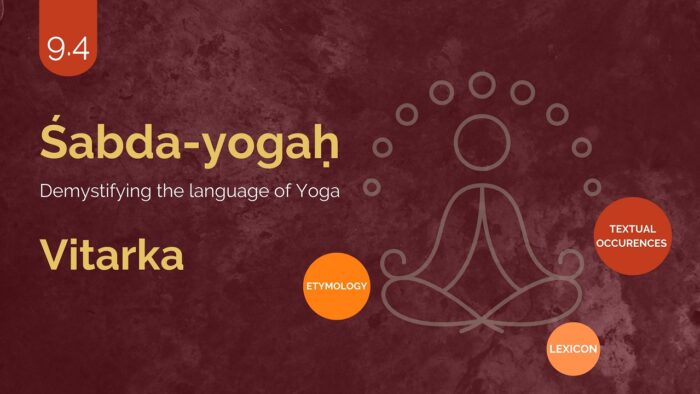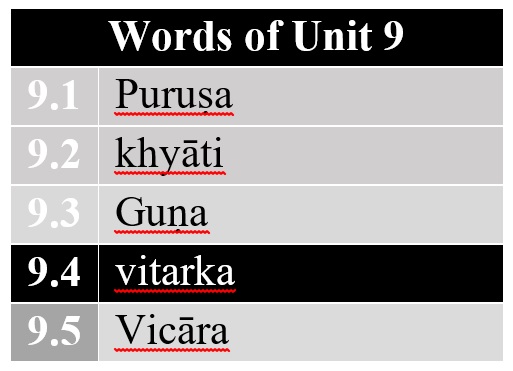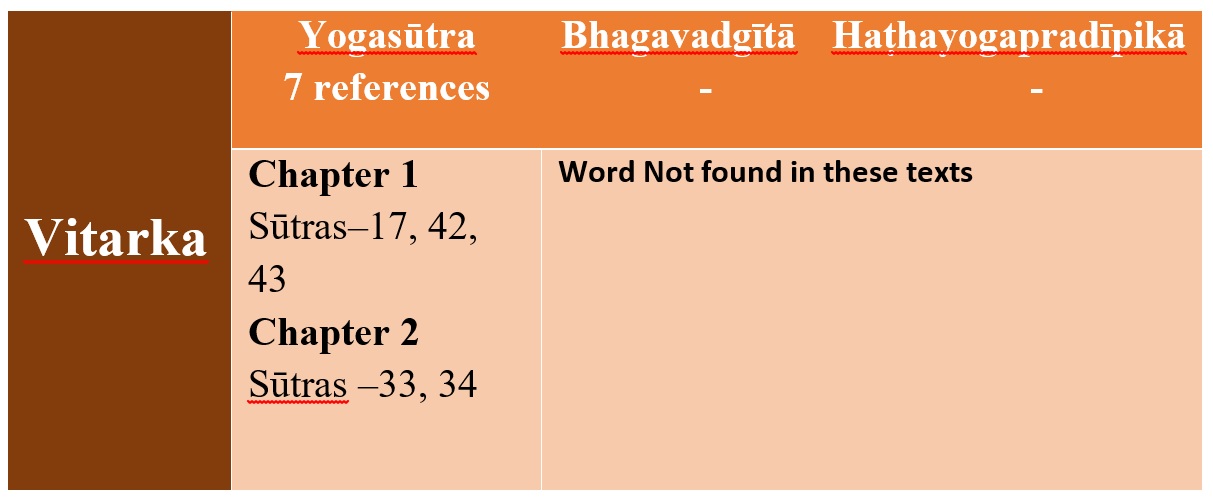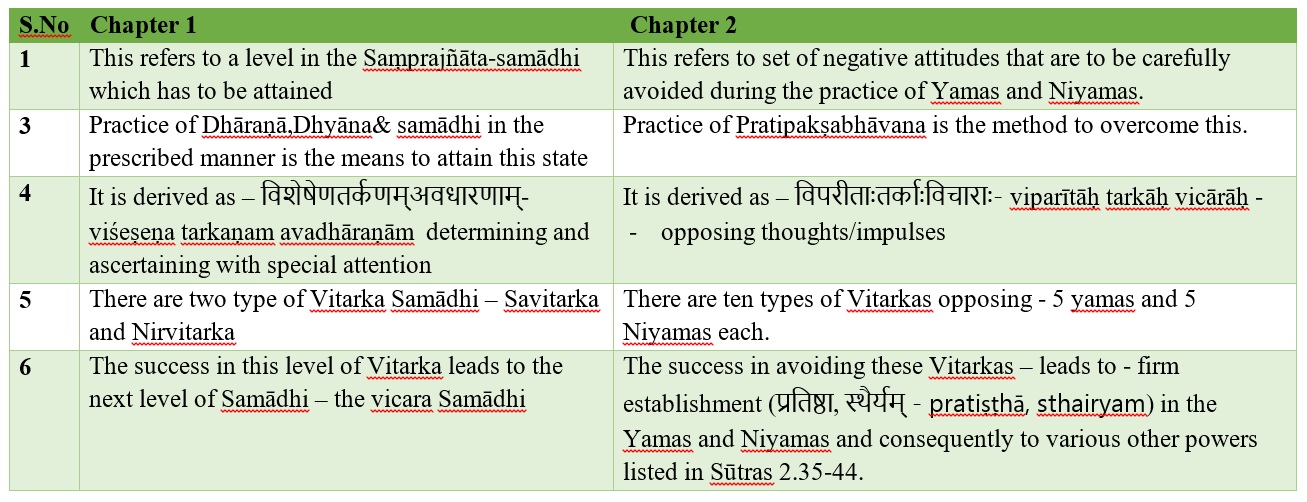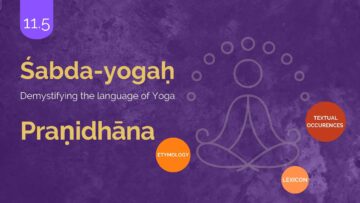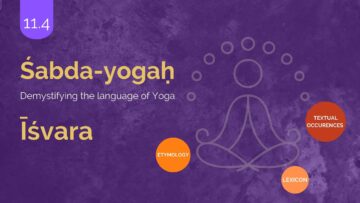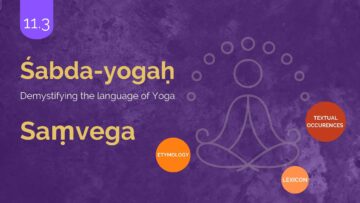Introduction
In this series, Yogic terminologies will be taken up and their –
- Etymological analysis,
- Lexical descriptions and
- Textual occurrences in Yogic literature and their commentaries, as available, will be presented. And finally observations will be made on the references.
Three texts – Yogasūtra, Haṭha-yoga-pradīpikā and Bhagavad-gītā are consulted for textual occurrences portion.
Śabda-yoga is intended to help students, teachers, and professionals of Yoga to develop a sound grammatical, contextual, and thereby an authentic and immersive understanding of Yoga terminologies.
List of Words
From among the above five words for this unit 9, this part discusses the fourth word Vitarka.
Etymology
वि + तर्क + घञ् = वितर्कः
vi + tarka + ghañ = vitarkaḥ
- विvi is the prefix that may mean both विशेष&विरुद्ध- viśeṣa viruddha – special and also opposite (in the context of the word Vitarka)
- Tarka is the root that means भाषा bhāṣā – to speak, to talk
- घञ्Ghañ is the suffix that means भाव bhāva – the act. The suffix is added as per the Grammar rule भावे bhāve (aṣṭādhyāyī 3.3.18)
Based on the above – the derivate statement would be – विशेषेणतर्क्यते, विरुद्धतयातर्क्यतेइति viśeṣeṇa tarkyate, viruddhatayā tarkyate iti – the act of special speech or opposite speech.
Lexicon
In amarakośa there is no entry of this term.
Textual occurrences
Yogasūtra
There are five references to Vitarka in this text found only in the first and second chapters. They are discussed chapter-wise.
Pāda 1
वितर्कविचारानन्दास्मितारूपानुगमात्संप्रज्ञातः॥१.१७॥
vitarkavicārānandāsmitārūpānugamātsaṃprajñātaḥ .. 1.17 ..
तत्रशब्दार्थज्ञानविकल्पैःसंकीर्णासवितर्कासमापत्तिः॥१.४२॥
tatra śabdārthajñānavikalpaiḥ saṃkīrṇā savitarkā samāpattiḥ .. 1.42 ..
स्मृतिपरिशुद्धौस्वरूपशून्येवार्थमात्रनिर्भासानिर्वितर्का॥१.४३॥
smṛtipariśuddhau svarūpaśūnyevārthamātranirbhāsā nirvitarkā .. 1.43 ..
In Sūtra 1.17 – Vitarka is mentioned as the first of the four levels of the Saṃprajñātasamādhi. Therein traditional commentators clarify the meaning of the term Vitarka in the following manner –
- The Etymology of the term Vitarka in the context of Samādhi is given both in Vārttika & Yogasiddhāntacandrikā commentaries as – विशेषेणतर्कणमवधारणंवितर्क: viśeṣeṇa tarkaṇamavadhāraṇaṃ vitarka: – special act of ascertaining and determining.
- Sage Vyāsa and other commentators clarify that – in the Vitarka level of the Samādhi – the gross aspect of the object focus – perceptible to the senses- is meditated upon. (वितर्कश्चित्तस्याऽऽलम्बनेस्थूलआभोगःvitarkaścittasyā”lambane sthūla ābhogaḥ – Vyāsa). Other commentators clarify that the gross aspect refers to the focusing upon the Bhūtas – the five elements and the sense organs (भाव्यभूतेन्द्रियगोचरसाक्षात्कारःसवितर्कःbhāvyabhūtendriyagocarasākṣātkāraḥ savitarkaḥ – Sadāśiva Brahmendra).It has been stated in Yoga-siddhānta-candrikā – it could be the four-armed (Catur-bhuja) form (of Bhagavān Nārāyaṇa) – (स्थूलांशचतुर्भुजादेःसाक्षात्कारोवितर्कःsthūlāṃśacaturbhujādeḥ sākṣātkāro vitarkaḥ.Yoga-siddhānta-candrikā)
- The details of the method of focusing in the Vitarka stage are clarified by another commentator Nāgojī Bhaṭṭa. He states that the mind should be so completely immersed in the object – as to be able to bring out all dimensions of the object of focus – that is not generally noticed during common sensory perception – both in the spatial and temporal dimensions. The knowledge should also include both virtues and problems pertaining to the object of focus. Such is the Vitarka-samādhi (तत्रालम्बनेस्थूलयोर्महाभूतेन्द्रिययोर्विद्यमानानामशेष-विशेषाणामतीतानागतवर्तमानव्यवहितविप्रकृष्टानांगुणदोषाणामदृष्टाश्रुतामतानामपिपूर्वापरानुसंधानेनशब्दार्थोल्लेखेनचभावनयायःसाक्षात्कारःसवितर्कइत्युच्यते tatrālambane sthūlayormahābhūtendriyayorvidyamānānāmaśeṣa-viśeṣāṇāmatītānāgatavartamānavyavahitaviprakṛṣṭānāṃ guṇadoṣāṇāmadṛṣṭāśrutāmatānāmapi pūrvāparānusaṃdhānena śabdārthollekhena ca bhāvanayā yaḥ sākṣātkāraḥ sa vitarka ityucyate – Nāgojī Bhaṭṭa)
Sūtras 42 and 42 of the first Pāda discuss the Savitarka and Nirvitarka divisions of the Vitarka Samādhi presented above. Based on these two Sūtras it could be seen that while in Savitarka state there is an admixture of the – word, object and knowledge – in the Nirvitarka state –the object alone shines forth in the intellect – bereft of any other connections of word and knowledge.
Pāda 2
वितर्कबाधनेप्रतिपक्षभावनम्॥२.३३॥
vitarkabādhane pratipakṣabhāvanam .. 2.33 ..
वितर्काहिंसादयःकृतकारितानुमोदितालोभक्रोधमोहपूर्वकामृदुमध्याधिमात्रादुःखाज्ञानानन्तफलाइतिप्रतिपक्षभावनम्॥२.३४॥
vitarkā hiṃsādayaḥ kṛtakāritānumoditā lobhakrodhamohapūrvakā mṛdumadhyādhimātrā duḥkhājñānānantaphalā iti pratipakṣabhāvanam .. 2.34 ..
Vitarka in the above two sūtras of the second chapter of the Yogasūtras are indeed used in a very different connotation than that of the first chapter.
- As could be seen from the Sūtra 2.34 Vitarka refer to Violence and other activities that are opposed to the Yamas and Niyamas that have been discussed in the preceding Sūtras of the chapter. For example –Ahimsā (non-violence) is the Yama and the Vitarka to that is Himsā (violence). Satya (truth) is the Yama and the asatya (falsehood) is its Vitarka. Thus it could be seen that Vitarkas are the opposing attitudes to the 10 virtues in the form of Yamas and Niyamas. Here the commentators have derived the term Vitarka as विपरीतास्तर्काविचाराः – वार्त्तिक- opposing tarkas- notions (विपरीतास्तर्काविचाराः–वार्त्तिकम्viparītāstarkā vicārāḥ – vārttikam).
- Sūtra 2.33 states that if a practitioner is afflicted by Vitarka (vitarka-bādhana) then one should practice Pratipakṣabhāvana (thinking about the detrimental effects of indulging in those opposing acts).
- Sūtra 2.34 clarifies the method of Pratipakṣabhāvana to douse the Vitarkas. It involves in thinking –
- Vitarkas point not only to indulging in violence etc, it also includes inciting others into violence etc, and approving someone’s act of violence – In essence – Vitarka comes in various forms. One should be wary of it.
- The Vitarkas are caused by/preceded by Lobha (greed), Krodha (anger) and Moha(delusion) – hence they do not have very noble origins
- Vitarkas may be of varying degree of intensity – mild, moderate and intense – all these are detrimental to and distracting from the noble goal of Yoga.
- All the Vitarkas invariably lead to endless suffering and ignorance.
Bhagavadgītā & Haṭhayogapradīpikā
This term is not found in the both these texts.
Tabulation on Distribution of References in Yoga Texts
From the above Śabdayogadiscussions –
1) It could be seen that Vitarka is a term unique to Yogasūtras – not to be found in the other two types of texts.
2) Even in Yogasūtras – the meaning of the term in the first chapter is entirely different and unrelated to the self-same term in the second chapter.
The following table collects and compares the differences of the two Vitarkas of Yoga – that have emerged from the references above
Tabulation of differences of the term in two Chapters ofYogasūtras
Thus it becomes clear that mere dictionary meanings of terms of Yogasūtra may not bring forth the intended the meaning of Yogic terms like Vitarka. A complete immersioninto the relevant texts (as has been done in Śabdayoga) only will lead to the manifestation of intended meanings.
Unit 9 To be Continued…
Links for previous posts in this unit
Disclaimer: The opinions expressed in this article belong to the author. Indic Today is neither responsible nor liable for the accuracy, completeness, suitability, or validity of any information in the article.

